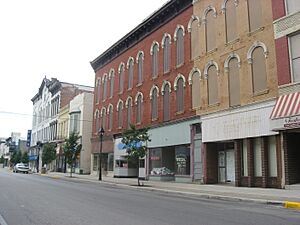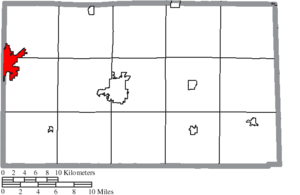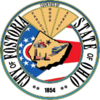Fostoria, Ohio facts for kids
Quick facts for kids
Fostoria, Ohio
|
|||
|---|---|---|---|

Main Street in downtown Fostoria
|
|||
|
|||

Location of Fostoria in Seneca County
|
|||
| Country | United States | ||
| State | Ohio | ||
| Counties | Seneca, Hancock, Wood | ||
| Area | |||
| • Total | 7.79 sq mi (20.18 km2) | ||
| • Land | 7.57 sq mi (19.62 km2) | ||
| • Water | 0.22 sq mi (0.56 km2) | ||
| Elevation | 774 ft (236 m) | ||
| Population
(2020)
|
|||
| • Total | 13,046 | ||
| • Estimate
(2023)
|
13,039 | ||
| • Density | 1,722.47/sq mi (665.05/km2) | ||
| Time zone | UTC-5 (Eastern (EST)) | ||
| • Summer (DST) | UTC-4 (EDT) | ||
| ZIP code |
44830
|
||
| Area code(s) | 419, 567 | ||
| FIPS code | 39-28014 | ||
| GNIS feature ID | 1086945 | ||
Fostoria is a city in the northwestern part of Ohio, a state in the United States. It's special because it sits where three different counties meet: Hancock, Seneca, and Wood.
In 2020, about 13,046 people lived in Fostoria. The city is about 40 miles (64 km) south of Toledo and 90 miles (145 km) north of Columbus. Fostoria grew a lot in the late 1800s. This was when there was a big natural gas boom in northwest Ohio. Like many cities in the "Rust Belt" (an area known for its industrial past), Fostoria was at its largest in 1970.
Fostoria was once a major center for making glass. It had more than a dozen glass factories in the late 1800s. But as the natural gas supply ran out, many factories closed or moved away. Today, Fostoria is famous for its railroads. Around 100 trains pass through the city every day! Because of this, many railfans (people who love trains) visit the city. There's even a special park where they can watch the trains.
Contents
Fostoria's Story: How the City Began
Fostoria was formed in 1854. It happened when two smaller communities, Rome and Risdon, decided to join together. This merger happened because of a gift from Charles W. Foster. He donated land for their Methodist churches to combine. To thank him, the new community was named Fostoria.
Charles W. Foster's son, Charles Foster, became a very important person from Fostoria. He was the 35th governor of Ohio. He also served as the United States Secretary of the Treasury under President Benjamin Harrison.
Glass City Days: A Look at Fostoria's Past
Fostoria is well-known for its history with glass making and its busy railroads. In downtown Fostoria, two main CSX train lines and one NS main line cross each other. This area is called the "Iron Triangle."
In the 1880s, there was a natural gas boom in the area. This, along with the existing train lines and efforts to attract businesses, helped Fostoria become home to many glass factories. Some of these included the Mambourg Glass Company (the city's first), the Fostoria Glass Company, the Seneca Glass Company, and the Novelty Glass Company.
Railroads: Fostoria's Enduring Connection
Even though the natural gas and glass booms are over, railroads are still very important to Fostoria. More than 100 trains travel through the city each day.
The Fostoria Railroad Preservation Society built a special park for watching trains. It was finished in 2013 with help from a large grant. This park helps the city welcome thousands of railfans who visit every year.
Fostoria's Location and Size
Fostoria covers a total area of about 7.77 square miles (20.18 square kilometers). Most of this area, about 7.55 square miles (19.62 square kilometers), is land. The rest, about 0.22 square miles (0.56 square kilometers), is water.
Who Lives in Fostoria: Population Facts
The population of Fostoria has changed over the years. Here's a quick look at how many people have lived there:
| Historical population | |||
|---|---|---|---|
| Census | Pop. | %± | |
| 1860 | 1,027 | — | |
| 1870 | 1,733 | 68.7% | |
| 1880 | 3,569 | 105.9% | |
| 1890 | 7,070 | 98.1% | |
| 1900 | 7,730 | 9.3% | |
| 1910 | 9,597 | 24.2% | |
| 1920 | 9,987 | 4.1% | |
| 1930 | 12,790 | 28.1% | |
| 1940 | 13,453 | 5.2% | |
| 1950 | 14,351 | 6.7% | |
| 1960 | 15,732 | 9.6% | |
| 1970 | 16,037 | 1.9% | |
| 1980 | 15,743 | −1.8% | |
| 1990 | 14,983 | −4.8% | |
| 2000 | 13,931 | −7.0% | |
| 2010 | 13,441 | −3.5% | |
| 2020 | 13,046 | −2.9% | |
| 2023 (est.) | 13,039 | −3.0% | |
| Sources: | |||
Fostoria's Population in 2010
In 2010, there were 13,441 people living in Fostoria. These people lived in 5,417 households, and 3,432 of these were families. The city had about 1,780 people per square mile (687 per square kilometer).
Most of the people in Fostoria were White (84.1%). About 6.4% were African American, and 11.5% were of Hispanic or Latino background.
About 33% of households had children under 18 living with them. The average age of people in Fostoria was 37.9 years old. About 26% of residents were under 18.
Getting Around and Water Supply
Transportation in Fostoria
Fostoria has its own airport, called Fostoria Metropolitan Airport. The city used to have Amtrak train service called the Three Rivers. This train traveled between Chicago and New York City. However, this service ended in 2005.
Fostoria is famous for its "Iron Triangle" railroad crossing. Here, the Norfolk Southern Railway line crosses two CSX lines. This spot is very popular for train enthusiasts. There's even a park right in the middle of these three main lines where people can watch the trains.
Fostoria's Public Water System
The City of Fostoria manages the public water system. It provides water to about 15,000 people and 5,500 homes and businesses. Fostoria also supplies water to the nearby Village of Arcadia.
The water comes from the East Branch of the Portage River. Most of this water is stored in six large reservoirs. The city also has three groundwater wells that can be used as a backup water source. The water plant can clean about 6.08 million gallons of water each day. Currently, it cleans about 2.2 million gallons daily.
Famous People from Fostoria
Many interesting people have come from Fostoria, including:
- Charlie Earl: A former state representative in Ohio.
- Charles Foster: The son of the city's namesake. He was a former governor of Ohio and a U.S. Secretary of the Treasury.
- Edward R. Hays: A soldier, lawyer, and politician who served in the U.S. House of Representatives.
- Micah Hyde: A professional football player.
- Grant Jackson: A left-handed pitcher who played for six different Major League Baseball teams.
- Tony Lucadello: A well-known baseball scout.
- Damon Moore: A professional football player.
- John Quinn: A famous art collector.
- Gene Sharp: A scholar known for his work on nonviolent action. He was also nominated for the Nobel Peace Prize.
- Harold L. Yochum: An American theologian and church leader.
See also
 In Spanish: Fostoria (Ohio) para niños
In Spanish: Fostoria (Ohio) para niños





